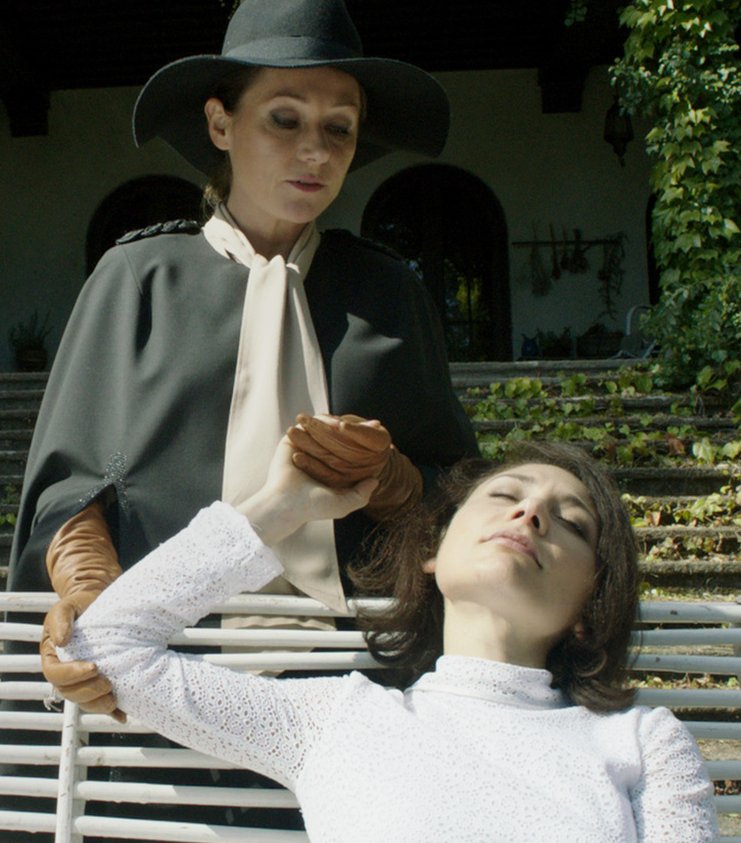Karen Pollock explores the themes behind The Duke of Burgundy, a story of love, betrayal and how far we will go to please a lover.
This piece contains plot spoilers for the film The Duke of Burgundy, and discusses BDSM including referencing watersports.
The Duke of Burgundy is a film about desire, written and directed by Peter Strickland. Set in a world without men, without explanation, it not only passes the Bechdel test, it blows it out of the water. We are expected to simply accept a world of women, where the butterfly museum is their focus, their battle field and their employer. It is also a world without religion, and I wondered watching if these two things were connected in the mind of Strickland. Without men would we have the religion which so often has been used to control female sexuality? With the removal of men Strickland also seems to have tackled the thorny problem of how to depict women’s enactment of desire whilst avoiding the perils of performance for the male gaze. This is a film where lesbianism is not defined by its relationship to the male, a form of ‘not male’ desire, but instead simply is, without having to defend or define itself.
The history of the fight for LGBTQ+ rights has in large part been a history of who it is acceptable for us to desire, and how those desires are expressed. To use a famous example, the prosecution of Oscar Wilde was in large part motivated by the visibility, and class of his partners. If only he had kept to his own kind, behind closed doors, was the subtext to the judge’s summing up. The initial demand from the Marquis of Queensbury was the Wilde and Bosie stop meeting in public restaurants. Keep your desires out of sight, so we do not have to acknowledge they exist. We fast forward to today, and the many, legitimate, criticisms of the same sex marriage campaigns based on their framing of queer desire as respectable, contained, out of sight and above all “normal”
The core of the film is a relationship between Evelyn (Chiara D’Anna) and Cynthia (Sidse Babette Knudsun). Our first introduction to them is as Mistress and servant, in a style very reminiscent of the works of feminist pornographers such as Pandora Blake. The stern Mistress, or Domme, cold and calculating, with her adoring submissive, at her feet. Our preconceptions are shattered when we discover that each of the “scenes” between them, the boot polishing, the punishment with water sports, the harsh words, have been scripted by Evelyne, the supposed servant. Strickland has made a film about power, but not the power exchange we might have been expecting. He forces us to ask the question, what does love look like? Many of the scenes might seem shocking, most particularly when we are locked out of the bathroom, listening, like the voyeuristic Evelyne to someone choking as they are urinated over. Imagine then discovering that Cynthia is only doing this, behaving in a way that many will find unacceptable, out of her love for Evelyne.
The history of the fight for LGBTQ+ rights has in large part been a history of who it is acceptable for us to desire, and how those desires are expressed
The Duke of Burgundy looks at these unacceptable desires, at the idea that women are meant to want sex for what it brings, marriage, children, not as a thing of itself. Lesbians are supposed to exist for the male gaze, or be unattractive and sexless, and kink, kink is unacceptable as it reinforces gender norms, so why would women, without men, even engage in it? The very idea of a woman desiring to submit, or to dominate shakes our idea of normal in the same way Wilde desiring working class male sex workers shook his peers. The film goes further though, creating a world where the Carpenter (Fatma Mohammed) has a 6 month waiting list for her specialised products, where the expression of desire via dominance and submission is so much the norm that Cynthia feels unable to say no to her lover.
The word deviant comes to mind, when women express sexuality, away from men, away from the male gaze pinning them down, they deviate from what is acceptable, and very often can never access that respectability, acceptability, again. When you add kink and sexuality to that the deviance becomes a challenge to all ideas of how women “should” be. The LGBTQ+ community has of late become uncomfortable with deviance, declaring instead that love wins, and it’s a heteronormative, monogamous, vanilla love. In fact the queer kink venn diagram has huge overlapping intersections. Just as the first pride parades were led by the leather community, so those who have said, my desire cannot be contained, will not be respectable, does not need to be acceptable to the majority, have straddled the worlds of kink and queerness.
When I watched this film for the first time a quote from Pat Califia came to mind;
‘I’m very fond of the concept of choice as the basis for sexual preference. This point of view is unpopular in an era in which every claim for gay rights is based on pseudoscientific sulking about how we can’t help being queer; we’re just born that way. Thanks, but I don’t want to receive my civil rights as a charity fuck bequeathed on me by my genetic superiors.’
Perhaps the most deviant, dangerous, idea of them all is that women might want sex, might choose to submit, might be in control of their desires, regardless of what the world thinks of them. Cynthia and Evelyn explore their desires, within their dreamlike world, and it is us, the observers, who are left wondering what is normal, acceptable, deviant and what choices we might make for love.
Click here for more information on how to buy The Duke of Burgundy
Follow Karen on twitter (@counsellingkaz)


Thanks for the article. I put this on my Netflix and watch this weekend. Looks fascinating.
LikeLike
would love to know your thoughts after you see it!
LikeLiked by 1 person
It was fascinating. I gained much insight into a dom/sub relationship. I had never considered that the sub actually runs the show. I wonder how such a situation comes about? One would have to feel very secure in their status before being brave enough to broach the subject with your lover. You would have to face possible rejection, ridicule, perhaps even disgust. Relationship might even end! I would imagine there would be a lot of oblique, subtle talk going on before being comfortable enough to suggest it.
As to this movie specifically, I have to say I simply loved the costumes! The actresses, the setting, the music, everything was just terrific. And hot! I enjoyed it very much. Thanks for the suggestion.
LikeLike
I loved the look of the film too, and the wonderful shoes provoked quite a lot of femme envy 🙂
LikeLiked by 1 person